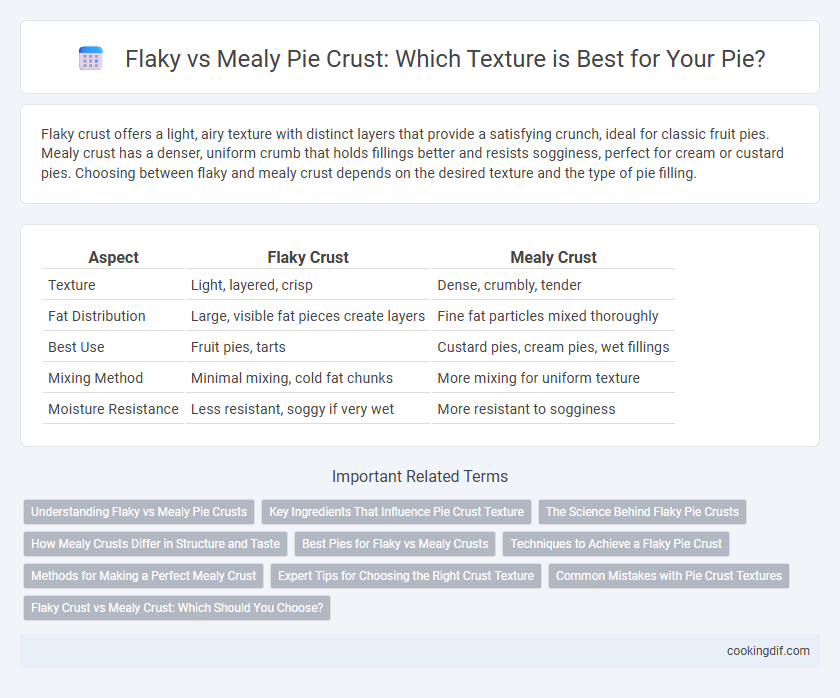Flaky crust offers a light, airy texture with distinct layers that provide a satisfying crunch, ideal for classic fruit pies. Mealy crust has a denser, uniform crumb that holds fillings better and resists sogginess, perfect for cream or custard pies. Choosing between flaky and mealy crust depends on the desired texture and the type of pie filling.
Table of Comparison
| Aspect | Flaky Crust | Mealy Crust |
|---|---|---|
| Texture | Light, layered, crisp | Dense, crumbly, tender |
| Fat Distribution | Large, visible fat pieces create layers | Fine fat particles mixed thoroughly |
| Best Use | Fruit pies, tarts | Custard pies, cream pies, wet fillings |
| Mixing Method | Minimal mixing, cold fat chunks | More mixing for uniform texture |
| Moisture Resistance | Less resistant, soggy if very wet | More resistant to sogginess |
Understanding Flaky vs Mealy Pie Crusts
Flaky pie crusts are characterized by distinct, thin layers created by cold fat pieces that separate the dough, producing a crisp, airy texture ideal for fruit pies. Mealy crusts have a finer, crumbly texture resulting from evenly distributed fat throughout the flour, providing a tender, sturdy base suited for custard or cream pies. Selecting between flaky and mealy crust depends on the desired pie filling and mouthfeel, impacting overall dessert quality.
Key Ingredients That Influence Pie Crust Texture
Flaky pie crusts are primarily achieved by incorporating cold, solid fats like butter or shortening, which create distinct layers as the fat melts during baking, while mealy crusts rely on finely ground fats that blend thoroughly with flour for a denser, crumbly texture. The type of fat, its temperature, and the mixing method significantly influence the crust's tenderness and structure; for instance, less water and more fat yield flakier results, whereas higher hydration and thorough mixing produce a mealy consistency. Using pastry flour or all-purpose flour also affects the crust's texture, with lower protein content favoring tenderness and minimizing gluten development to prevent toughness.
The Science Behind Flaky Pie Crusts
Flaky pie crusts develop through the layering of cold, solid fat within the dough, which melts during baking to create pockets of steam that separate the dough layers. The key to achieving this texture lies in minimal gluten development and proper fat incorporation, ensuring distinct flaky layers instead of a dense, uniform crumb typical of mealy crusts. Temperature control and gentle handling preserve these fat layers, resulting in the characteristic crisp, delicate flakiness prized in pie baking science.
How Mealy Crusts Differ in Structure and Taste
Mealy pie crusts have a finer, crumbly texture due to higher fat content cutting the flour particles into smaller pieces, resulting in less gluten development than flaky crusts. This structure creates a tender, sandy mouthfeel that absorbs pie fillings well and resists sogginess. The taste of mealy crusts is buttery and rich with a subtle density, contrasting the light, layered flakiness of traditional pie crusts.
Best Pies for Flaky vs Mealy Crusts
Flaky crusts, characterized by distinct, crisp layers, excel in pies like apple or cherry where a light, airy texture enhances the juicy fruit filling. Mealy crusts, with a dense, tender crumb, suit custard or pumpkin pies by providing sturdy support and preventing sogginess. Choosing between flaky and mealy dough depends on balancing texture and filling moisture to achieve the best pie experience.
Techniques to Achieve a Flaky Pie Crust
In achieving a flaky pie crust, using cold fat such as butter or shortening and cutting it into small, pea-sized pieces helps create distinct layers that puff up during baking. Incorporating minimal water and handling the dough gently prevents gluten overdevelopment, ensuring a tender, crisp texture. Chilling the dough before rolling and baking at a high temperature also promotes optimal flakiness by solidifying fat and generating steam pockets.
Methods for Making a Perfect Mealy Crust
Using cold fat and minimal water in pie dough preparation enhances a perfect mealy crust by promoting a tender, crumbly texture rather than flakiness. Incorporating fine flour and carefully mixing ingredients until just combined prevents gluten overdevelopment, ensuring a smooth, cohesive crust. Chilling the dough thoroughly before baking retains the mealy structure and avoids puffiness common in flaky crusts, ideal for cream or fruit pies requiring a delicate, melt-in-the-mouth base.
Expert Tips for Choosing the Right Crust Texture
Flaky crusts, characterized by visible layers and a light, buttery texture, are achieved through cold butter and minimal handling, ideal for fruit and savory pies requiring crispness. Mealy crusts, with a finer, crumbly texture created by thoroughly blending fat and flour, excel in custard or cream pies where sturdiness prevents sogginess. Experts recommend selecting flaky crust for airy, tender bites and mealy crust for moisture-resistant, dense fillings to optimize pie texture and overall eating experience.
Common Mistakes with Pie Crust Textures
Flaky crust develops from solid fat pieces that create layers during baking, while mealy crust results from fat thoroughly cut into flour, producing a uniform, crumbly texture. Common mistakes include using overly warm butter for flaky crust, which causes fat to melt too soon, and overmixing dough for mealy crust, leading to toughness instead of tenderness. Proper temperature control and minimal handling are essential to achieve the desired flaky or mealy texture in pie crusts.
Flaky Crust vs Mealy Crust: Which Should You Choose?
Flaky crust features distinct layers of butter that create a light, crisp texture perfect for fruit pies and pot pies, while mealy crust uses finely ground fat for a tender, crumbly crumb ideal for custard or cream pies. Choosing flaky crust enhances a pie's structural integrity and bite, complementing fillings that benefit from a flaky contrast, whereas mealy crust provides a sturdier base that prevents sogginess in wet or smooth fillings. For optimal pie texture, select flaky crust for airy, layered bites and mealy crust when a delicate, melt-in-your-mouth consistency is preferred.
Flaky crust vs mealy crust for pie texture Infographic

 cookingdif.com
cookingdif.com